KSEEB Class 11 Physics Solutions For Motion in a Straight Line Chapter 3 Motion In A Straight Line Very Short Answer Questions
Question 1. The states of motion and rest are relative Explain.
Answer:
Rest: If the position of a body does not change with respect to its surroundings, it is said to be at “rest”.
Motion: If the position of a body changes with respect to its surroundings, it is said to be in “motion”.
By definitions rest and motion are relative with respect to surroundings.
Read and Learn More KSEEB Class 11 Physics Solutions
Question 2. How is average velocity different from instantaneous velocity?
Answer:
Average Velocity: It is the ratio of total displacement to total time taken. It is independent of the path of the body.
∴ Average velocity = \(\frac{\mathrm{s}_2-\mathrm{s}_1}{\mathrm{t}_2-\mathrm{t}_1}(\mathrm{Or}) \mathrm{V}_{\text {avg }}=\frac{\mathrm{ds}}{\mathrm{dt}}\)
The velocity of a particle at a particular instant of time is known as instantaneous velocity. Here time interval is very small.
V = \(\frac{dx}{dt}\)
Only in uniform motion, instantaneous velocity = average velocity. For all other, cases instantaneous velocity may differ from average velocity.
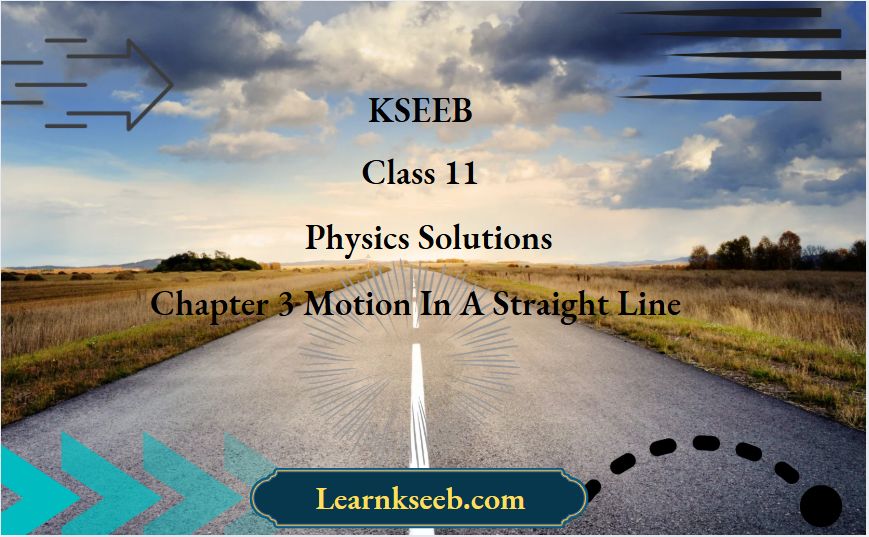
Question 3. Give an example where the velocity of an object is zero but its acceleration is not zero.
Answer:
In the case of a Vertically Projected Body at maximum height its velocity v = 0. But acceleration due to gravity ’g’ is not zero
So even though velocity v = 0 ⇒ acceleration is not zero.
Question 4. A vehicle travels half the distance L with speed v1 and the other half with speed v2 What is the average speed?
Answer:
The average speed of a vehicle for the two equal parts \(\frac{L}{2}\), \(\frac{L}{2}\) is
⇒ \(V_{\text {avg }}=\frac{\text { Total distance }}{\text { Total time }}=\frac{\frac{L}{2}+\frac{L}{2}}{t_1+t_2}\) (because \(t=\frac{L / 2}{V}\))
⇒ \(V_{\text {avg }}=\frac{L}{\left(\frac{\frac{L}{2}}{V_1}+\frac{\frac{L}{2}}{V_2}\right)} \)
= \(\frac{L}{\frac{L}{2}\left(\frac{1}{V_1}+\frac{1}{V_2}\right)}\)
= \(\frac{1}{\frac{1}{2}\left(\frac{V_1+V_2}{V_1 V_2}\right)}\)
∴ \(V_{\text {avg }}=\frac{2 V_1 V_2}{V_1+V_2}\)
Motion In A Straight Line Solutions KSEEB Class 11 Physics
Question 5. A lift coming down is just about to reach the ground floor. Taking the ground floor as the origin and positive direction upwards for all quantities, which one of the following is correct?
- x < 0, v < 0, a > 0
- x > 0, v < 0, a < 0
- x > 0, v < 0, a > 0
- x > 0, v > 0, a > 0
Answer:
As the lift is coming down, the value of x becomes less hence negative, i.e., x < 0.
Velocity is downwards (i.e., negative). So v < 0.
Just before reaching the ground floor, the lift is retarded, i.e., acceleration is upwards. Hence a > 0.
We can conclude that x < 0, v < 0 and a > 0.
∴ (1) is correct.
Question 6. A uniformly moving cricket ball is hit with a bat for a very short time and is turned back. Show the variation of its acceleration with time taking the acceleration in the backward direction as positive.
Answer:
For a ball moving with uniform velocity acceleration is zero. But during the time of contact between the ball and bat acceleration is applied in the opposite direction. The shape of the acceleration – time graph is as shown.
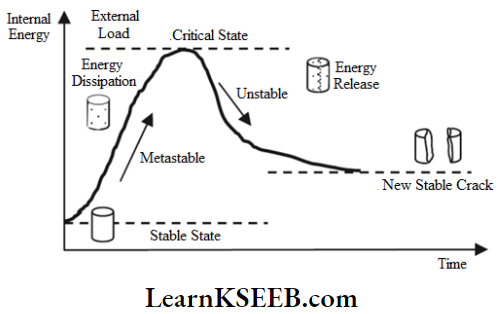
Question 7. Give an example of one-dimensional motion where a particle moving along the positive x-direction comes to rest periodically and moves forward.
Answer:
When the length of the pendulum is high and the amplitude is less then its motion is along a straight line. The pendulum will come to a stop at the extreme position and move back in the forward direction (‘x’ + ve) periodically.
Question 8. An object falling through a fluid is observed to have an acceleration given by a = g – bv where g is the gravitational acceleration and b is a constant. After a long time, it is observed to fall with a constant velocity. What would be the value of this constant velocity?
Answer:
Acceleration, a = g – bv when moving with constant velocity, a = 0 ⇒ 0 = g – bv
∴ Constant velocity, v = \(\frac{g}{b}\) m/sec.
Question 9. If the trajectory of a body is parabolic in one frame, can it be parabolic in another frame that moves with a constant velocity with respect to the first frame? If not, what can it be?
Answer:
If the trajectory of a body is parabolic with reference frames one and two then those two frames are of rest or moving with uniform velocity.
If they are not parabolic then for that reference frame it may be in a straight line path.
Example: When a body is dropped from a moving plane its path is parabolic for a person outside the plane. But for the pilot in the plane, it is falling vertically downwards.
Question 10. A spring with one end attached to amass and the other to rigid support is stretched and released. When is the magnitude of acceleration a maximum?
Answer:
Maximum restoring force set up in the spring when stretched by a distance ‘r’ is F = – kr
Potential energy of stretched spring = \(\frac{1}{2}\) kx²
As F ∝ r and this force are directed towards the equilibrium position, hence if the mass is left free, it will execute damped SHM due to gravity pull.
Magnitude of acceleration in the mass attached to one end of spring when just released is \(\mathrm{a}=\frac{\mathrm{F}}{\mathrm{m}}=\frac{-\mathrm{k}}{\mathrm{m}} \mathrm{r}=(\text { Maximum })\)
∴ The magnitude of the spring’s acceleration will be maximum when it is just released.
KSEEB Class 11 Physics Chapter 3 Solutions
Question 11. Define average velocity and average speed. When does the magnitude of average velocity become equal to the average speed?
Answer:
Average Velocity: It is defined as the ratio of total displacement to total time taken.
Average velocity = \(\frac{\text { total displacement }}{\text { total time taken }}=\frac{\mathrm{x}_2-\mathrm{x}_1}{\mathrm{t}_2-\mathrm{t}_1}\)
Average velocity is independent of the path followed by the particle. It just deals with the initial and final positions of the body.
Average Speed: The ratio of the total path length travelled to the total time taken is known as “average speed”.
Speed and average speed are scalar quantities so no direction for these quantities.
Average speed = \(\frac{\text { Total path length }}{\text { Total time interval }}\)
When the body is along with the straight line its average velocity and average speed are equal.
Solutions For Motion In A Straight Line KSEEB Physics Chapter 3 Short Answer Questions
Question 1. Can the equations of kinematics be used when the acceleration varies with time? If not, what form would these equations take?
Answer:
The equations of motion are
- v =u + at
- s = ut + \(\frac{1}{2}\)at² and
- v² – u² = 2as.
All these three equations are applicable to body moves with uniform acceleration ‘a’.
No, the equations are not applicable when the acceleration varies with time.
Question 2. A particle moves in a straight line with uniform acceleration. Its velocity at time t = 0 is v1 and at time t2 = t is v2. The average velocity of the particle in this time interval is (v1 + v2) / 2. Is this correct? Substantiate your answer.
Answer:
t1 = 0 ⇒ u = v1; t2 = t ⇒ v = v2
Average velocity = \(\frac{u+v}{2}=\frac{v_1+v_2}{2}\)
Question 3. Can the velocity of an object be in a direction other than the direction of acceleration of the object? If so, give an example.
Answer:
Yes, the Velocity of a body and its acceleration may be in different directions.
Explanation:
- In the case of a vertically projected body ⇒ velocity of the body is in the upward direction and acceleration is in a downward direction.
- When brakes are applied the velocity of the body before coming to rest is opposite to retarding acceleration.
Question 4. A parachutist flying in an aeroplane jumps when it is at a height of 3 km above the ground. He opens his parachute when he is about 1 km above ground. Describe his motion.
Answer:
Initially, the path is a parabola as seen by an observer on the ground. It is a vertical straight line as seen by the pilot. He opens his parachute, it is moving vertically downwards with decreasing velocity and finally, it reaches the ground.
Question 5. A bird holds n fruit In its beak and flics parallel to the ground. It lets go of the fruit at some height. Describe the trajectory of the fruit as it falls to the ground as seen by
- The bird
- A person on the ground.
Answer:
- As the bird Is flying parallel to the ground, it possesses velocity in the horizontal direction. Hence the fruit also possesses velocity in the horizontal direction and acceleration in a downward direction. Hence the path of the fruit is a straight line with respect to the bird.
- With respect to a person on the ground, the fruit seems to be on a parabolic path.
Question 6. A man runs across the roof of a tall building and jumps horizontally onto the (lower) roof of an adjacent building. If his speed is 9 ms-1 the horizontal distance between the buildings is 10 m and the height difference between the roofs is 9 m, will he be able to land on the next building? (take g = 10 ms-2)
Answer:
Given that,
initial speed, u = 9 ms-1 ; g = 10m/s²
The height difference between the roofs, h = 9 m
Horizontal distance between two buildings, d = 10 m
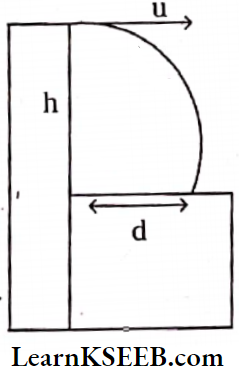
Time of flight \(\mathrm{T}=\sqrt{\frac{2 \mathrm{~h}}{\mathrm{~g}}}=\sqrt{\frac{2 \times 9}{10}}\)
= \(\sqrt{1.8}=1.341 \mathrm{~s}\)
Range of the man = R = u x T = 9 x 1.341 s = 12.069 m
Since R > d, the man will be able to land on the next building.
Question 7. A ball is dropped from the roof of a tall building and simultaneously another ball Is thrown horizontally with some velocity from the same roof. Which ball lands first? Explain your answer.
Answer:
Let ‘h’ be the height of the tall building.
For Dropped Ball: Let ‘t1‘ be the time taken by the dropped ball to reach the ground.
Initial velocity, u = 0 ; Acceleration, a = + g
Distance travelled, s = h; Time of travel, t = t1
From the equation of motion, s = ut + \(\frac{1}{2}\) at²
We can write, h = \(0 \times t_1+\frac{1}{2} \times g \times t_1^2 \Rightarrow h=\frac{1}{2} g t_1^2 \Rightarrow t_1^2=\frac{2 h}{g}\)
(or) \(t_1=\sqrt{\frac{2 h}{g}}\)…..(1)
For Horizontally Projected Ball: If the ball is thrown horizontally then its initial velocity along the vertical direction is zero and in this case, let ‘t2‘ be the time taken by the ball to reach the ground.
Again from the equation of motion,
s = \(\mathrm{ut}+\frac{1}{2} \mathrm{at}^2\) we can write,
⇒ h = \(0 \times \mathrm{t}_2+\frac{1}{2} \mathrm{~g} \times \mathrm{t}_2^2\)
⇒ h = \(\frac{1}{2} \mathrm{gt}_2^2 ;\)
⇒ \(\mathrm{t}_2^2=\frac{2 \mathrm{~h}}{\mathrm{~g}}\) (or)
∴ \(\mathrm{t}_2=\sqrt{\frac{2 \mathrm{~h}}{\mathrm{~g}}}\)…….(2)
From equation (1) and (2) t1 = t2
i.e., both the balls reach the ground at the same time.
Question 8. A ball Is dropped from a building and simultaneously another ball is projected upward with some velocity. Describe the change In relative velocities of the balls as a function of time.
Answer:
- For a body dropped from building its velocity, v1 = gt…..(1) (u1 = 0)
- For a body thrown up with a velocity ‘u’ its velocity, v² = u – gt….(2)
The two balls are moving in the opposite direction the relative velocity, vR = v1 + v2
∴ vR = gt + u – gt = u
Here the relative velocity remains constant, but the velocity of one body increases at a rate of ‘g’ m/sec and the velocity of another body decreases at a rate of ‘g’m/sec.
Question 9. A typical raindrop is about 4 mm in diameter. If a raindrop falls from a cloud which is 1 km above the ground, estimate its momentum when it hits the ground.
Answer:
Diameter, D = 4 m
⇒ radius, r = 2mm = 2 x 10-3 m
mass of raindrop = volume x density = \(\frac{4}{3} \pi r^3 \times 1000 \mathrm{~m}\)
(mass of one m³ of water = 1000 kg)
∴ m = \(\frac{4}{3} \times \frac{22}{7} \times\left[2 \times 10^{-3}\right]^3 \times 1000\)
= \(33.52 \times 10^{-6} \mathrm{~kg}\)
Velocity of raindrop \(v=\sqrt{2 g h}\)
But h = 1 km = 1000 m
∴ \(\mathrm{v}=\sqrt{2 \times 9.8 \times 1000}=\sqrt{19600}\) = 140 m/sec
Momentum of raindrop, \(\vec{p}=m v\)
= 33.52 x 10-6 x 140 = 4.693 x 10-3 kg-m
Question 10. Show that the maximum height reached by a projectile launched at an angle of 45° is one-quarter of its range.
Answer:
In projectiles Range, \((R)=\frac{u^2 \sin 2 \theta}{g}\)
Maximum height \((H)=\frac{u^2 \sin ^2 \theta}{2 g}\)
When \(\theta=45^{\circ}\)
⇒ \(\mathrm{R}_1=\mathrm{R}_{\max }=\frac{\mathrm{u}^2 \sin 90^{\circ}}{\mathrm{g}}\)
∴ \(\mathrm{R}_{\max }=\frac{\mathrm{u}^2}{\mathrm{~g}}\)
Maximum height \(H_{\max }=\frac{u^2 \sin ^2\left(45^{\circ}\right)}{2 g}\)
= \(\frac{u^2(1 / \sqrt{2})^2}{2 g}=\frac{u^2}{4 g}\)
∴ \(H_{\max }=\frac{1}{4} R_{\max }\)
∴ When θ = 45° maximum height reached is one-quarter of the maximum range.
Question 11. Derive the equation of motion x = v0t + \(\frac{1}{2}\) at² using appropriate graph.
Answer:
The velocity-time graph of a body moving with initial velocity ‘u’ and with uniform acceleration ‘a is shown. Let V be the velocity of the body after a time t.
In the v -t graph area of the velocity-time graph = total displacement travelled by it. The area under velocity – time graph = area of OABCD
∴ Area of Rectangular part OACD = Area of OACD + Area of ABC.
A1 = OA x OD = v0 t…….(1)
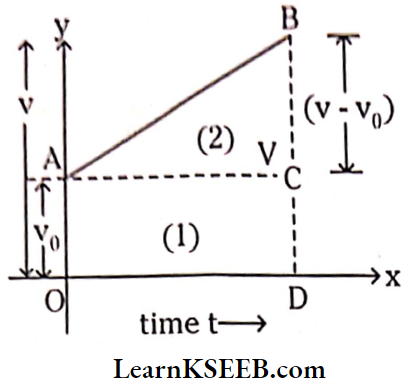
Area of triangle ABC = A2
A2 = \(\frac{1}{2}\) Base x height
= \(\frac{1}{2}\) AC x (BC)
= \(\frac{1}{2}\)t(v-v)
But v – v0 = at
∴ A2 = \(\frac{1}{2}\)t at = \(\frac{1}{2}\) at²
∴ Total area under graph = s = A1 + A2
s(n)= \(v_0 t+\frac{1}{2} a t^2\) is graphically proved.
KSEEB Physics Class 11 Motion in a Straight Line Chapter 3 Problems
Question 1. A man walks on a straight road from his home to a market 2.5 km away with a speed of 5 km h-1. Finding the market closed, he instantly turns and walks back home at a speed of 7.5 km h-1. What is the
- Magnitude of average velocity and
- The average speed of the man over the time interval of 0 to 50 minutes?
Solution:
Time taken by man to go from his home to market, \(\mathrm{t}_1=\frac{\text { distance }}{\text { speed }}=\frac{2.5}{7.5}=\frac{1}{3} \mathrm{~h}\)
∴ Total time taken = \(t_1+t_2=\frac{1}{2}+\frac{1}{3}=\frac{5}{6} h\) = 50 min
In time interval 0 to 50 min
Total distance travelled = 2.5 + 2.5 = 5 km.
Total displacement = zero.
- Average velocity = \(\frac{\text { displacement }}{\text { time }}=0\)
- Average speed = \(\frac{\text { displacement }}{\text { time }}=\frac{5}{\frac{5}{6}}\) = 6 km/h
Question 2. A stone is dropped from a height of 300 m and at the same time, another stone is projected vertically upwards with a velocity of 100 m/sec. Find when and where the] two stones meet.
Solution:
Height h = 300 m ;
Initial velocity u0 = 100 m/s
Let the two stones meet at a height ‘x’ above the ground.
For 1st stone \(\mathrm{h}-\mathrm{x}=\frac{1}{2} \mathrm{gt}^2\)…..(1)
For 2nd stone \(\mathrm{x}=\mathrm{u}_0 \mathrm{t}-\frac{1}{2} \mathrm{gt}^2\)
⇒ \(\frac{1}{2} g t^2=u_0 t-x\)….(2)

Since t is the same for the two stones
From equations 1 and 2.
h – x = u0t – x
⇒ \(\mathrm{u}_0 \mathrm{t}=\mathrm{h} \text { or time } \mathrm{t}=\frac{\mathrm{h}}{\mathrm{u}_{\mathrm{o}}}=\frac{300}{100}=3 \mathrm{sec}\).
⇔ The two stones will meet 3 seconds after the 1st stone is dropped or the 2nd stone is thrown up.
Question 3. A car travels the first third of a distance with a speed of 10 kmph, the second third at 20 kmph and the last third at 60 kmph. What is its mean speed over the entire distance?
Solution:
Total distance = s
distance travelled, \(\mathbf{s}_1=\frac{\mathbf{s}}{3}\)
velocity, v1 = 10 kmph
distance, \(\mathbf{s}_2=\frac{\mathbf{s}}{3}\)
velocity, v2 = 20 kmph
distance, \(\mathbf{s}_3=\frac{\mathbf{s}}{3}\)
velocity, v3 = 60 kmph
Average velocity = \(\frac{\text { total distance }}{\text { total time }}\)
Time, \(t=t_1+t_2+t_3=\frac{s}{3 v_1}+\frac{s}{3 v_2}+\frac{s}{3 v_3}\)
(because time = \(\frac{\text { distance }}{\text { velocity }}\)
∴ \(\mathrm{t}=\frac{\mathrm{s}}{3}\left(\frac{\mathrm{v}_2 \mathrm{v}_3+\mathrm{v}_3 \mathrm{v}_1+\mathrm{v}_1 \mathrm{v}_2}{\mathrm{v}_1 \mathrm{v}_2 \mathrm{v}_3}\right)\)
= \(\frac{\mathrm{s}}{3}\left[\frac{(60 \times 20)+(60 \times 10)+(20 \times 10)}{60 \times 20 \times 10}\right]\)
= \(\frac{\mathrm{s}}{3} \frac{(1200+600+200)}{12000}\)
= \(\frac{\mathrm{s}}{3} \frac{2000}{12000}=\frac{2000 \mathrm{~s}}{3 \times 12000}\) (Or)
∴ \(v_{\text {mean }}==\frac{3 v_1 v_2 v_3}{v_1 v_2+v_2 v_3+v_3 v_1}=18 \mathrm{kmph}\)
Average velocity = \(\frac{\mathrm{s}}{\mathrm{t}}\)
= \(\frac{3 \times 12000}{2000 \mathrm{~s}}\) = 18 kmph
Question 4. A bullet moving with a speed of 150 m s-1 strikes a tree and penetrates 3.5 cm before stopping. What is the magnitude of its retardation in the tree and the time taken for it to stop after striking the tree?
Solution:
Velocity of bullet, u = 150 m/s;
Final velocity, v = 0
Distance travelled, s = 3.5 cm = 3.5 x 10-2 m,
Acceleration, \(a=\frac{v^2-u^2}{2 s}\)
= \(\frac{0^2-150^2}{2 \times 3.50 \times 10^{-2}}\)
= \(\frac{-22500}{7 \times 10^{-2}}\)
= \(-3.214 \times 10^5 \mathrm{~m} / \mathrm{sec}^2\) (-ve sign for retardation)
Time taken to stop, \(\mathrm{t}=\frac{\mathrm{v}-\mathrm{u}}{\mathrm{a}}\)
= \(\frac{-150}{-3.214 \times 10^5}\)
= \(4.67 \times 10^{-4} \mathrm{sec}\)
Motion In A Straight Line Problems in KSEEB Physics
Question 5. A motorist drives north for 30 min at 85 km/h and then stops for 15 min. He continues travelling north and covers 130 km in 2 hours. What is his total displacement and average velocity?
Solution:
In First Part:
Velocity, v1 = 85 kmph
Time, t1 = 30 min
Distance travelled, s1 = v1 t1
= 85 x \(\frac{30}{60}\) =42.5 km
In Second Part:
Distance travelled, s2 = 0;
Time, t2 = 15.0 min.
In Third Part:
Distance travelled, s3 = 130 km;
Time, t3 = 120 min = 2 hours
1. Total distance of the motorist, s = s1+ s2 + s3 = 42.5 + 0 + 130 = 172.5 km
2. Total time travelled, t = t1 + t2 + t3 = 30 + 15 + 120
= 165 minutes
= 2 hrs 45 minutes
= 2\(\frac{3}{4}\) hrs. = \(\frac{11}{4}\) hrs.
∴ Average velocity, \(\mathrm{v}_{\mathrm{avg}}=\frac{\text { total displacement }}{\text { total time }}\)
= \(\frac{172.5}{(11 / 4)}=62.7 \mathrm{kmph}\)
Question 6. A ball A is dropped from the top of a building and at the same time an identical ball B is thrown vertically upward from the ground. When the balls collide the speed of A is twice that of B. At what fraction of the height of the building did the collision occur?
Solution:
Given at time of collision velocity of A = VA
= 2 x VB (velocity of B)
Let the body be dropped from a height ‘h’.
Let the two stones collide at x from the ground.
For the body dropped, \(\mathrm{s}=\mathrm{h}-\mathrm{x}=\frac{1}{2} \mathrm{gt}^2\)……(1)
For the body thrown up, x = ut – \(\frac{1}{2}\) gt²…….(2)
For the body dropped, v = u + at ⇒ VA = gt…….(3)
For the body thrown up, v = u – gt ⇒ VB = u – gt……..(4)
Given VA = 2VB
⇒ gt = 2 (u – gt) or u = \(\frac{3gt}{2}\)…… (5)
Divide equation (1) with equation (2)
⇒ \(\frac{h-x}{x}=\frac{\frac{1}{2} g t^2}{u t-\frac{1}{2} g t^2} \Rightarrow \frac{h}{x}-1=\frac{\frac{1}{2} g t^2}{u t-\frac{1}{2} g t^2}\)
⇒ \(\frac{h}{x}=\frac{\frac{1}{2} g t^2+u t-\frac{1}{2} g t^2}{u t-\frac{1}{2} g t^2}\)
∴ \(\frac{h}{x}=\frac{u t}{u t-\frac{1}{2} g t^2}\)
Put u = \(\frac{3 g t}{2}\) then \(\frac{h}{x}=\frac{3 g t^2 / 2}{3 g t^2 / 2-\frac{1}{2} g t^2}\)
∴ \(\frac{h}{x}=\frac{3 g t^2}{2 g t^2}=\frac{3}{2}\)
∴ x = \(\frac{2}{3} h\)
∴ Fraction of height of collision = \(\frac{2}{3}\)
KSEEB Class 11 Physics Motion in a Straight Line Key Concepts
Question 7. Drops of water fall at regular intervals from the roof of a building of height 16 m. The first drop strikes the ground at the same moment as the fifth drop leaves the roof. Find the distances between successive drops.
Solution:
Height of building, h = 16 m
∴ Time taken to reach the ground, t = \(\sqrt{\frac{2 h}{g}}\)
∴ Time taken to fall, t =\(\sqrt{\frac{2 \times 16}{9.8}}\)
= \(\sqrt{\frac{32}{9.8}}=\sqrt{3.26}=1.80\)
Number of drops, n = 5
∴ Number of intervals = n — 1 = 5 — 1 = 4
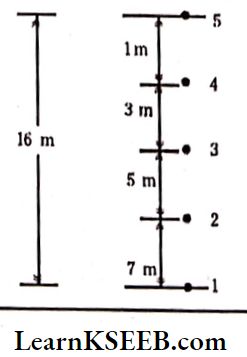
Time interval between drops = \(\frac{1.8}{4}\) = 0.45 sec
Time of travel of 1st drop, t1 = 4 x 0.45 = 1.81
∴ Distance travelled by 1st drop, \(s_1=\frac{1}{2} g t_1^2=\frac{1}{2} \times 9.8 \times 1.8 \times 1.8=16 \mathrm{~m}\)
For 2nd drop, t2 = 3 x0.45 = 1.35 sec., \(\mathrm{S}_2=\frac{1}{2} \mathrm{gt}_2^2\);
= \(4.9 \times 1.822 \simeq 1.822=9 \mathrm{~m}\)
For 3rd drop, \(\mathrm{t}_3=2 \times 0.45=0.9 \mathrm{sec}\)
Distance \(\mathrm{S}_3=\frac{1}{2} \mathrm{gt}_3^2=\frac{1}{2} \times 9.8 \times 0.9^2 =3.97\) = 4m
For 4th drop, \(t_4=1 \times 0.45=0.45 \mathrm{sec}\)
Distance travelled, \(\mathrm{S}_4=\frac{1}{2} \mathrm{gt}_4^2=\frac{1}{2} \times 9.8\) \(\times(0.45)^2 \simeq 1\)
For 5 th drop, t5 = 0 ⇒ S5 = 0
Distance between 1st and 2nd drop S1,2 = S1 – S2 = 16-9 = 7 m
Distance between 2nd and 3rd drop S2,3 = S2 – S3 = 9 – 4 = 5m
Distance between 3rd and 4th drop S3,4 = S3 – S4 = 4 – 1= 3 m
Distance between 4th and 5th drop S4,5 = S4 – S5 = 1-0 = 1 m
∴ Distances between successive drops are 7m, 5m, 3m and lm.
Question 8. Rain is falling vertically with a speed of 35 ms-1. A woman rides a bicycle with a speed of 12 ms-1 in east to west direction. What is the direction in which she should hold her umbrella?
Answer:
Velocity of rain VR = 35 m/s (vertically)
Velocity of women Vw = 12 m/s (towards east)

Resultant angle = \(\theta=\tan ^{-1} \frac{\mathrm{V}_{\mathrm{W}}}{\mathrm{V}_{\mathrm{R}}}=\frac{12}{35}\)
∴ \(\theta=\tan ^{-1}\left[\frac{12}{35}\right]=0.343 \text {. or } \theta=19^{\circ}\) (Nearly)
She should hold an umbrella at an angle of 19° with the east.
Question 9. A hunter aims a gun at a monkey hanging from a tree some distance away. The monkey drops from the branch at the moment he fires the gun hoping to avoid the builet. Explain why the monkey made a wrong move.
Answer:
Let the bullet be fired with an angle α and distance from hunter’s rifle to monkey = x
The vertical component of velocity vxy = v sin α
when exactly aimed at monkey Sy = v sinα t = h
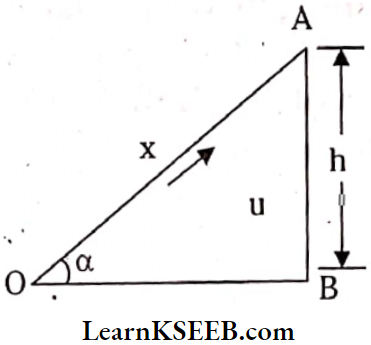
But acceleration due to gravity \(h_1=u \sin \alpha \mathrm{t}-\frac{1}{2} g t^2=h-\frac{1}{2} g t^2\)….(1)
So the bullet passes through a height of \(\frac{1}{2}\) gt² below the monkey.
But when the monkey is falling freely height of fall during time t = \(\frac{1}{2}\)
So new height is h – \(\frac{1}{2}\) gt² …… (2)
From equations (1) and (2) h1 is the same i.e., if the monkey is dropped from the branch bullet will hit it exactly.
KSEEB Physics Motion In A Straight Line Questions And Answers
Question 10. A food packet is dropped from an aeroplane, moving with a speed of 360 kmph in a horizontal direction, from a height of 500m. Find
- It is a time of descent
- The horizontal distance between the point at which the food packet reaches the ground and the point above which it was dropped.
Solution:
The velocity of plane, V = 360 kmph = 360 x \(\frac{5}{18}\) = 100 m/s
Height above ground, h = 500 m; g = 10 m/s²
1. Time of descent, \(\mathrm{t}=\sqrt{\frac{2 h}{g}}=\sqrt{\frac{2 \times 500}{10}}=\sqrt{100}=10 \mathrm{sec}\)
2. Horizontal distance between the point of dropping and the point where it reaches the ground = Range R.
∴ R = \(u \sqrt{\frac{2 h}{g}}=100 \sqrt{\frac{2 \times 500}{10}}\) = 100 x 10 = 1000 m.
Question 11. A ball is tossed from the window of a building with an initial velocity of 8 ms-1 at an angle of 20° below the horizontal. It strikes the ground 3 s later. From what height was the ball thrown? How far from the base of the building does the ball strike the ground?
Solution:
Initial velocity, u = 8 m/s;
The angle of projection, θ = 20°
Time is taken to reach the ground, t = 3 sec.
The horizontal component of initial velocity, ux = u cos θ = 8 cos 20° = 8 x 0.94 = 7.52 m/s
Vertical component of initial velocity, vy = u sin θ = 8 sin 20° = 8 x 0.342 = 2.736 m/s
1. From equation of motion, s = ut + \(\frac{1}{2}\) at²
we can write h = (u sinθ)t + \(\frac{1}{2}\) gt²
⇒ h = (2.736)3 + \(\frac{1}{2}\) x 9.8 x(3)² .
⇒ h = 8.208+ 4.9 x 9
⇒ h = 8.208 + 44.1 or h = 52.308 m
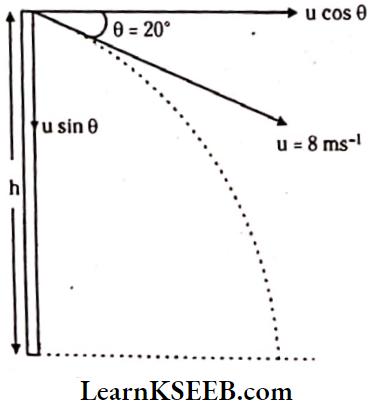
2. Horizontal distance travelled, sx = vx x t = 7.52 x 3 = 22.56 m
Question 12. Two balls are projected from the same point in directions 30° and 60° with respect to the horizontal. What is the ratio of their initial velocities if they
- Attain the same height?
- Have the same range?
Solution:
The angle of projection of the first ball, θ1 =30°
The angle of projection of the second ball, θ2 = 60°
Let u1 and u2 be the velocities of projections of the two balls.
1. Maximum height of the first ball, \(\left(\mathrm{H}_{\max }\right)_1=\frac{\mathrm{u}_1^2 \sin ^2 30^{\circ}}{2 \mathrm{~g}}\)
Maximum height of second ball, \(\left(\mathrm{H}_{\max }\right)_2=\frac{\mathrm{u}_2^2 \sin ^2 60^{\circ}}{2 \mathrm{~g}}\)
Given that \(\left(H_{\max }\right)_1=\left(H_{\text {max }}\right)_2\)
⇒ \(\frac{u_1^2 \sin ^2 30^{\circ}}{2 g}=\frac{u_2^2 \sin ^2 60^{\circ}}{2 g}\)
⇒ \(u_1^2 \sin ^2 30^{\circ}=u_2^2 \sin ^2 60^{\circ}\)
⇒ \(\frac{u_1^2}{u_2^2}=\frac{\sin ^2 60^{\circ}}{\sin ^2 30^{\circ}} \Rightarrow \frac{u_1^2}{u_2^2}=\frac{(\sqrt{3} / 2)^2}{(1 / 2)^2}\)
⇒ \(\frac{u_1}{u_2}=\frac{\sqrt{3}}{1}\) or \(u_1: u_2=\sqrt{3}: 1\)
2. If the balls have the same range, then \(R_1=R_2\)
i.e., \(\frac{u_1^2 \sin \left(2 \times 30^{\circ}\right)}{g}=\frac{u_2^2 \sin \left(2 \times 60^{\circ}\right)}{g}\)
⇒ \(u_1^2 \sin 60^{\circ}=u_2^2 \sin 120^{\circ}\)
⇒ \(\frac{u_1^2}{u_2^2}=\frac{\sin 120^{\circ}}{\sin 60^{\circ}} \Rightarrow \frac{u_1^2}{u_2^2}=\frac{\cos 30^{\circ}}{\sin 60^{\circ}}\)
⇒ \(\frac{u_1^2}{u_2^2}=\frac{\frac{\sqrt{3}}{2}}{\frac{\sqrt{3}}{2}} \text { or } u_1: u_2=1: 1\)
Question 13. A ball is thrown vertically upwards with a velocity of 20 ms-1 from the top of a multistory building. The height of the point from where the hall Is thrown Is 25.0 in from the ground.
- How high will the ball rise?
- How long will it be before the ball hits the ground?
- Take g = 10 ms-2 [Actual value of ‘g’ is 9.8 ms-2]
Solution:
Initial velocity V0 = 20 m/s;
Height above ground h0 = 2.50 m ; g = 10 m/s²
1. For a body thrown up vertically height of rise \(\left(y-y_0\right)=\frac{u^2}{2 g}=\frac{20 \times 20}{2 \times 10}=20 \mathrm{~m}\)
2. Time spent in the air (t) is \(y_1-y_0=V_0 t+\frac{1}{2} g t^2\)
Where y1 = Total displacement of the body from the ground = 0
∴ 0 = \(y_0+V_0 t+\frac{1}{2} g t^2=25+20 t-\frac{1}{2} \cdot 10 . t^2\)
(because \(g=-10 \mathrm{~m} / \mathrm{s}^2\)) while going up
∴ \(0=-5 t^2+20 t+25\) (or) \(t^2-4 t-5=0\)
i.e., (t-5)(t+1)=0
t=5 (or) t=-1
But time is not – ve.
∴ Time spent in air t = 5 sec
KSEEB Class 11 Physics Chapter 3 Motion In A Straight Line
Question 14. A parachutist flying in an aeroplane jumps when it is at a height of 3 km above ground. He opens his parachute when he is about 1 km above ground. Describe his motion.
Answer:
1. Height of fall before opening, h = 2 km = 2000 m
∴ Velocity at a height of 1 km
= \(\sqrt{2 \mathrm{gh}_1}=\sqrt{2 \times 10 \times 2000}\)
= \(\sqrt{40000}=200 \mathrm{~ms}^{-1}\)
Time of fall, t = \(\sqrt{\frac{2 h}{g}}=\sqrt{\frac{2 \times 2000}{10}}\)
= \(\sqrt{400}=20 \mathrm{sec}\)
2. After the parachute Is opened It touches the ground with almost zero velocity.
∴ u = 200 m/sec, v = 0, S = h = 1000 m
From v² – u² = 2as
Retardation, \(a=\frac{0-200^2}{1000}=-40 \mathrm{~m} / \mathrm{sec}^2\)
Time taken to reach ground, t = \(\frac{u}{a}\) = \(\frac{200}{40}\) = 5 sec
The month is as shown.
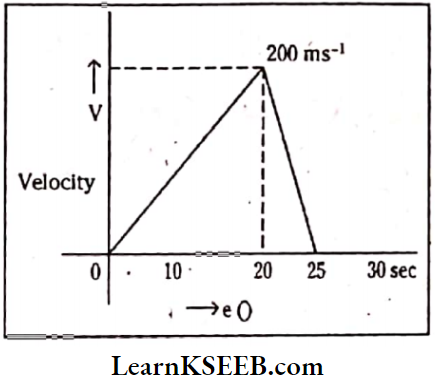
Question 15. A car moving along a straight highway with a speed of 126 km/h is brought to a stop within a distance of 200 m. What is the retardation of the car (assumed uniform) and how long does it take for the car to stop?
Solution:
Initial speed = V0 = 126 kmph
= 126 x \(\frac{5}{18}\) = 35 m/sec
Ending speed = V = 0
Distance taken to stop = X = 200 m.
From V² – V0² = 2ax .
a = \(\frac{-35}{2 \times 200}\) = \(\frac{-35 \times 35}{2 \times 200}\) = \(\frac{-49}{16}\)
Time taken to stop t =?
From V = V0 + at
0 = \(35+\frac{49}{16} \times t \Rightarrow t=\frac{35 \times 6}{49}\) = \(\frac{80}{7}=11.43 \mathrm{sec}\)
